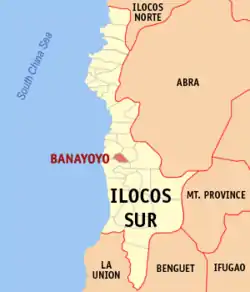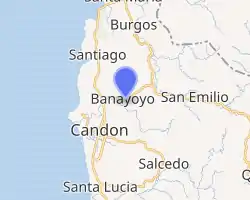Banayoyo
Banayoyo, officially the Municipality of Banayoyo (Ilocano: Ili ti Banayoyo; Filipino: Bayan ng Banayoyo), is a 4th class municipality in the province of Ilocos Sur, Philippines. According to the 2015 census, it has a population of 7,748 people. [3]
Banayoyo | |
|---|---|
| Municipality of Banayoyo | |
 Seal | |
 Map of Ilocos Sur with Banayoyo highlighted | |
OpenStreetMap 
| |
.svg.png.webp) Banayoyo Location within the Philippines | |
| Coordinates: 17°14′N 120°29′E | |
| Country | |
| Region | Ilocos Region (Region I) |
| Province | Ilocos Sur |
| District | 2nd District |
| Founded | 1912 |
| Barangays | 14 (see Barangays) |
| Government | |
| • Type | Sangguniang Bayan |
| • Mayor | Virgilio G. Galanga |
| • Vice Mayor | Oscar S. Gandalera Sr. |
| • Representative | Kristine Singson-Meehan |
| • Electorate | 6,001 voters (2019) |
| Area | |
| • Total | 24.63 km2 (9.51 sq mi) |
| Elevation | 69 m (226 ft) |
| Population | |
| • Total | 7,748 |
| • Density | 310/km2 (810/sq mi) |
| • Households | 1,780 |
| Economy | |
| • Income class | 4th municipal income class |
| • Poverty incidence | 12% (2015)[4] |
| • Revenue | ₱194,375,246.46 (2016) |
| Time zone | UTC+8 (PST) |
| ZIP code | 2708 |
| PSGC | |
| IDD : area code | +63 (0)77 |
| Climate type | tropical monsoon climate |
| Native languages | Ilocano Tagalog |
| Website | www |
Settlements in the municipality are mostly established along the roads and in the areas near the people’s sources of livelihood. With limited economic opportunities in the municipality, some residents of the town have also left their town to seek higher education, better employment opportunities, better opportunities for trade and commerce not only to other more developed areas in the country but even abroad.
Etymology
The municipality of Banayoyo was originally called “Bacsayan”. How it got its present name could be recounted by the following story: in the eastern part of Poblacion, there was a big tree, which was called “Banayoyo”. The people built a “Dap-ay” under the shady branches of the big tree, where the old folks held their meetings and settled any disputes or criminal acts committed by the barangay folks. After every bountiful harvest, the people gathered around the “Banayoyo” tree and offered their thanksgiving in a festivity called “Kaniaw”, the rituals lasting for three days.
Due to old age, the big “Banayoyo” tree died. The death of the big tree brought famine and drought. The calamity prompted the older folks to gather in the “Dap-ay” and decided to change the name of the community. The people thought of a name so that the big “Banayoyo” tree will always be remembered, and called the place “Banayoyo” instead of “Bacsayan”.
History
Creation of the municipality
In its earliest stage, Banayoyo was a “rancheria” (or a pasture land under the Spanish regime). But as more people from the highlands of Abra called “Tinguians” came to settle, it developed into a small community.
Before Banayoyo became a township, during the 18th century, it was part of the now municicpalities of Candon and Santiago. Reliable sources indicate that lands existing in the southern part of the town, particularly from Barangay Cadanglaan in the south-west to the Barangay Lopez in the Southeast, were registered in the local civil registrar at Candon, while lands in the northern part were also registered in the local civil registrar at Santiago before they were given new declarations by the local civil registrar of Banayoyo. It was only in the year 1907 when Banayoyo gained its township, separating itself from Candon and Santiago. In 1912, it became a Municipality under Ilocos Sur Province.
World War II
During World War II, Banayoyo was once the seat of ongoing local Philippine Commonwealth Military and Ilocano Guerilla Resistance Outfit, under the command of Army Major Walter M. Cushing, a fearless American fighter. The closeness of the residents to the Guerilla Outfit by way of provisions and financial assistance irked the Japanese Imperial Army, who were then garrisoned at an old Sugar Central in nearby Bucong, a barrio of Candon. Angry patrols of the Japanese Imperial Army burned down some barrios of Banayoyo. Barangay Elefante, which was the bivouac area of the elements of the “M” Company, 121st Infantry Regiment, Philippine Commonwealth Army, USAFIP NL, suffered the worst atrocities. On October 16, 1944, one half of the barrio was burned down and on November 14, 1944 the other half met the same fate. During the same dates, not only Elefante was set on fire but the whole town. The Banayoyo Catholic Church was not spared nor the Municipal Hall.
Geography
The municipality of Banayoyo is one of the 36 municipalities of Ilocos Sur in Region I. It is bounded on the south by the Bucong River, also called “Carayan a Bassit”; on the west by a small canal called “Calip”; on the east by the Cabcaburao Hills, and on the north by Bay-asan Hills. Municipalities abutting the town area are: on the east by Lidlidda; on the south by Candon; on the west by Santiago; and on the north by Burgos.
Banayoyo, which is one of the interior towns of Ilocos Sur, is approximately 3.5 kilometres (2.2 mi) east of the Manila North Road. It is 57 kilometres (35 mi) south of Vigan, the provincial capital city; 8.5 kilometres (5.3 mi) north-east of Candon; 85 kilometres (53 mi) from San Fernando, La Union, the regional capital; 145 kilometres (90 mi) from Baguio City; and 352 kilometres (219 mi) from Manila.
The municipality can be reached by jeepneys going to Lidlidda and San Emilio or tricycles from Candon.
Barangays
Banayoyo is politically subdivided into 14 barangays. [2]
- Bagbagotot
- Banbanaal
- Bisangol
- Cadanglaan
- Casilagan Norte
- Casilagan Sur
- Elefante
- Guardia
- Lintic
- Lopez
- Montero
- Naguimba
- Pila
- Poblacion
Climate
| Climate data for Banayoyo, Ilocos Sur | |||||||||||||
|---|---|---|---|---|---|---|---|---|---|---|---|---|---|
| Month | Jan | Feb | Mar | Apr | May | Jun | Jul | Aug | Sep | Oct | Nov | Dec | Year |
| Average high °C (°F) | 30 (86) |
31 (88) |
32 (90) |
34 (93) |
32 (90) |
31 (88) |
30 (86) |
30 (86) |
30 (86) |
31 (88) |
31 (88) |
30 (86) |
31 (88) |
| Average low °C (°F) | 18 (64) |
19 (66) |
21 (70) |
23 (73) |
24 (75) |
24 (75) |
24 (75) |
24 (75) |
24 (75) |
22 (72) |
21 (70) |
19 (66) |
22 (71) |
| Average precipitation mm (inches) | 10 (0.4) |
10 (0.4) |
14 (0.6) |
23 (0.9) |
80 (3.1) |
103 (4.1) |
121 (4.8) |
111 (4.4) |
119 (4.7) |
144 (5.7) |
39 (1.5) |
15 (0.6) |
789 (31.2) |
| Average rainy days | 5.2 | 3.9 | 6.2 | 9.1 | 18.5 | 21.4 | 22.9 | 19.8 | 19.8 | 16.2 | 10.5 | 6.1 | 159.6 |
| Source: Meteoblue [5] | |||||||||||||
Demographics
|
| |||||||||||||||||||||||||||||||||||||||||||||
| Source: Philippine Statistics Authority [3] [6] [7][8] | ||||||||||||||||||||||||||||||||||||||||||||||
In the 2015 census, the population of Banayoyo was 7,748 people, [3] with a density of 310 inhabitants per square kilometre or 800 inhabitants per square mile.
Many religions have been established in the municipality like Protestantism, Catholicism, Iglesia ni Cristo, Aglipayan, Jehovah’s Witnesses. Many residents have been given elementary and secondary education with the establishment of several elementary schools.
Socio-Economic-Cultural Development
Tinguians were the foremost inhabitants of the place, who came down from the highlands of Abra. With the coming of the Spaniards, Americans, Japanese, Chinese and other foreigners and people from nearby provinces of Ilocos Norte, La Union and Mountain Province, the original settlers intermingled with and intermarried with them,. At present, however, remnants of the Tinguian tribe still reside in the town.
Like before, farming is the major source of livelihood of the people. During the early period, they used crude methods of farming like plowing by the use of cows and carabaos, and tilling the soil by the hands or sticks. But with the coming of the Westerners who brought with them modern technologies, the farmers of Banayoyo have already adopted semi-mechanized methods of farming like the use of tractors, threshers, commercial fertilizers, etc.
References
- Municipality of Banayoyo | (DILG)
- "Province: Ilocos Sur". PSGC Interactive. Quezon City, Philippines: Philippine Statistics Authority. Retrieved 12 November 2016.
- Census of Population (2015). "Region I (Ilocos Region)". Total Population by Province, City, Municipality and Barangay. PSA. Retrieved 20 June 2016.
- "PSA releases the 2015 Municipal and City Level Poverty Estimates". Quezon City, Philippines. Retrieved 1 January 2020.
- "Banayoyo: Average Temperatures and Rainfall". Meteoblue. Retrieved 14 May 2020.
- Census of Population and Housing (2010). "Region I (Ilocos Region)". Total Population by Province, City, Municipality and Barangay. NSO. Retrieved 29 June 2016.
- Censuses of Population (1903–2007). "Region I (Ilocos Region)". Table 1. Population Enumerated in Various Censuses by Province/Highly Urbanized City: 1903 to 2007. NSO.
- "Province of Ilocos Sur". Municipality Population Data. Local Water Utilities Administration Research Division. Retrieved 17 December 2016.